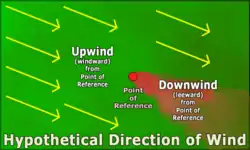Windward and leeward
In geography and seamanship, windward (/ˈwɪndwərd, ˈwɪnərd/) and leeward (/ˈliːwərd, ˈljuːərd/) are directions relative to the wind. Windward is upwind from the point of reference, i.e., towards the direction from which the wind is coming; leeward is downwind from the point of reference, i.e., along the direction towards which the wind is going.

The side of a ship that is towards the leeward is its "lee side". If the vessel is heeling under the pressure of crosswind, the lee side will be the "lower side". During the Age of Sail, the term weather was used as a synonym for windward in some contexts, as in the weather gage.
Since it captures rainfall, the windward side of a mountain tends to be wetter than the leeward side it blocks. The drier leeward area is said to be in a rain shadow.
Origin
The term "lee" comes from the middle-low German word /lē/ meaning "where the sea is not exposed to the wind" or "mild". The terms Luv and Lee (engl. Windward and Leeward) have been in use since the 17th century.[1]
Usage
Windward and leeward directions (and the points of sail they create) are important factors to consider in such wind-powered or wind-impacted activities as sailing, wind-surfing, gliding, hang-gliding, and parachuting. Other terms with broadly the same meaning are widely used, particularly upwind and downwind.[2]
Nautical
Among sailing craft, the windward vessel is normally the more maneuverable. For this reason, rule 12 of the International Regulations for Preventing Collisions at Sea, applying to sailing vessels, stipulates that where two are sailing in similar directions in relation to the wind, the windward vessel gives way to the leeward vessel.[3]
Naval warfare
In naval warfare during the Age of Sail, a vessel always sought to use the wind to its advantage, maneuvering if possible to attack from windward. This was particularly important for less maneuverable square-rigged warships, which had limited ability to sail upwind, and sought to "hold the weather gage" entering battle.[4]
This was particularly important once artillery was introduced to naval warfare. Ships heel away from the wind, so the leeward vessel would expose more of her topsides to shot, in extreme cases even part of her bottom.[5]
Describing islands
The terms windward and leeward are used in reference both to sides (and climates[6]) of individual islands and relative island locations in an archipelago. The windward side of an island is subject to the prevailing wind, and is thus the wetter (see orographic precipitation). The leeward side is the side distant from or physically in the lee of the prevailing wind, and typically the drier.
In an archipelago windward islands are upwind and leeward islands are downwind of the prevailing winds, such as the trade winds of the Atlantic and Pacific oceans.
See also
- Barlavento (windward) and Sotavento (leeward) in the Cape Verde Islands
- Downstream and upstream
- Foehn wind
- Lee shore
- List of nautical terms
- Northwestern Hawaiian Islands, also known as Leeward Islands
- Windward Islands, Leeward Islands and Leeward Antilles (in the Lesser Antilles)
- Windward Islands and Leeward Islands (in the Society Islands)
References
- "Duden | Luv | Rechtschreibung, Bedeutung, Definition, Herkunft". www.duden.de (in German). Archived from the original on 26 January 2021. Retrieved 7 December 2020.
- Patrick M. Royce (1 April 1993). Royce's Sailing Illustrated Course: Provides Lectures That Can Be Read Word for Word. ProStar Publications. pp. 11–. ISBN 978-0-911284-01-0. Archived from the original on 1 August 2020. Retrieved 17 November 2016.
- Navigators International Rules of the Road' 1998 Ed. Rex Bookstore, Inc. pp. 73–. ISBN 978-971-23-2239-6. Archived from the original on 1 August 2020. Retrieved 17 November 2016. Handling of the leeward vessel may be severely affected if she passes into the lee of the windward vessel. Handling of the windward vessel is free of such complication.
- David Childs (30 April 2014). The Warship Mary Rose: The Life and Times of King Henry VII's Flagship. Seaforth Publishing. pp. 127–. ISBN 978-1-4738-5285-3. Archived from the original on 1 August 2020. Retrieved 17 November 2016.
- Sam Willis (2008). Fighting at Sea in the Eighteenth Century: The Art of Sailing Warfare. Boydell Press. pp. 152–. ISBN 978-1-84383-367-3. Archived from the original on 1 August 2020. Retrieved 17 November 2016.
- Michael Pidwirny (5 September 2016). Glossary of Terms for Physical Geography. Our Planet Earth Publishing. pp. 286–. ISBN 978-0-9877029-0-6. Archived from the original on 1 August 2020. Retrieved 17 November 2016.